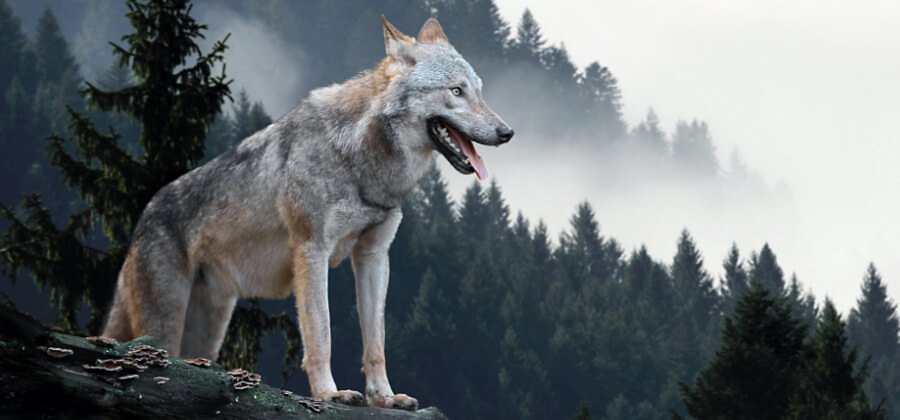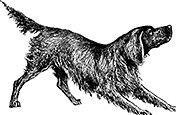The wild art of wolf drawing.
Learn the basics of drawing every kind of Canis lupus, from the realistic wolf for an album cover to a growling cartoon wolf in your graphic novel.

Symbols of creation, death, and rebirth.
Wolves are from the same family and genus as dogs and coyotes, but they’re larger, more social, and more vocal than other canines. From the she-wolf that raised the founders of ancient Rome to Fenrir, the giant wolf god in Norse mythology, to the creator god of the Pawnee, wolves hold a central place in human culture. And they look pretty cool too.
Start with reference photos.
Study your subject before you start any step-by-step drawing tutorials. Wolves have a distinctive appearance that sets them apart even from more wolfish dogs like huskies. Before you begin drawing wolves, examine some reference photos to get a sense of their features and proportions. “They look like they’re constantly looking out for themselves,” says artist Lucas Elliott. Note the wolves’ long legs, the thick neck scruff, and the leaner torso. “A wild animal is typically going to have a more severe and angular look because it has less fat,” artist Jonathan Case agrees. “Emphasize those angles when you’re drawing a wolf.”
Even the body posture of a wolf differs from that of a dog. “Wolves carry themselves like apex predators, much more upright than dogs. They move a little more elegantly,” says artist Megan Levens. When she’s drawing a wolf’s body, she says, “I think about what this animal is designed to do and focus on those features. So the legs are designed to run fast and catch prey. The jaws are strong to capture prey and kill it. The ears are perked up to stay alert.”
To gain an even better understanding of what the lines of a wolf should look like, practice sketching the basic shapes of some of your reference photos.

Image by Jonathan Case
First steps.
The process is basically the same whether you’re drawing a front view or side view, a howling wolf or a sleeping one. Begin drawing the wolf as you would other four-legged creatures like dogs, using curved lines to make shapes that represent the wolf’s head, rib cage, and pelvis, along with hinged rectangles for hind legs and front legs. Draw two triangles on top of the head for ears, noting that wolves’ ears tend to be proportionally smaller than those of a German shepherd. Draw a cone or oval to represent the snout.
Using your reference photos to guide you, start turning those basic shapes into a wolf by connecting and smoothing the lines. Sketch new lines to fix any mistakes in proportion.
Remember that part of being a good artist is being a good eraser. At this point, you can begin erasing your guidelines or, if you’re drawing digitally, hide the outline layer.
Refining your wolf.
When your wolf has a recognizable silhouette and major features, you can begin filling in the details. Bring out the body contours, shading in the shadows and suggesting muscles and variations in the fur. Recheck your reference photos to note the direction and texture of the fur. Also note how the light hits the ears and nose. Don’t forget the tail, which tends to be longer and bushier than a dog’s.
Here you can break out the colored pencils or digital brushes. With Adobe Fresco, you can experiment with a huge variety of brushes to get just the right texture or effect.

Focus on the eyes.
As wild predators, wolves depend on sight for survival. “Their eyes sit on the front of the face, more so than some dogs, because they need to be able to track prey,” Levens says. Their eyes tend to appear smaller than dogs’ as well. “Dogs have evolved alongside us, learning to communicate with us. Their eyes are always moving to check ours, but with wolves, you have the original genetic type. Their eyes are primed for hunting.” Wolf eye color also tends to be lighter than most dogs’, golden or yellow instead of a warm brown or husky blue. “I would paint them in lighter colors,” Levens says. “Big brown puppy-dog eyes on a wolf wind up suggesting a shaggy dog.”

Practice.
Wolves don’t give up when they fail to take down an elk. They just shake off the snow and try again. That’s what you should do if your first attempts don’t do the majestic wolf justice. Whether your aim is creating an image of a wolf howling or one stalking prey, just keep drawing. Once you feel comfortable with the form, you can experiment easily with oil and watercolor painting in Adobe Fresco to add new depth to your wolves.
Contributors
Lucas Elliott,Jonathan Case, Megan Levens
You might also be interested in…
How to draw birds of any feather.
Learn the basics of drawing birds digitally with this step-by-step tutorial.
Learn how to draw horses.
Discover tips to take on the challenge of drawing these big, beautiful creatures.
How to draw a dog.
Learn new tricks for creating drawings that capture canine personality and emotion.
How to become a professional illustrator.
Get tips on portfolio creation and art presentation to help you kick off a new career.



